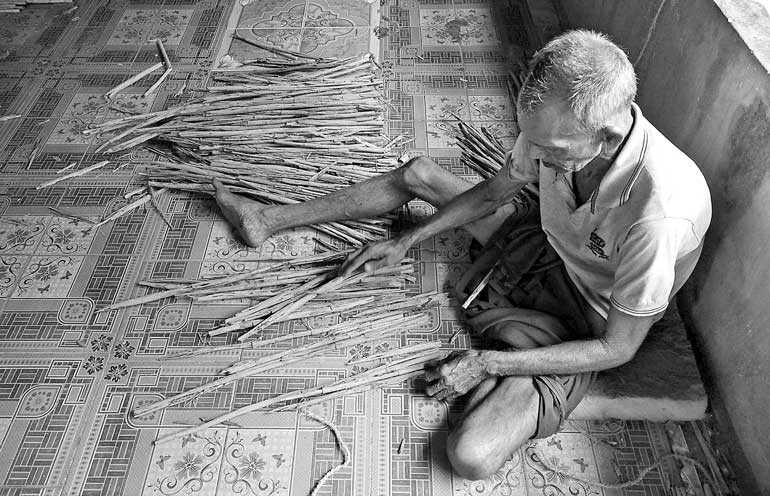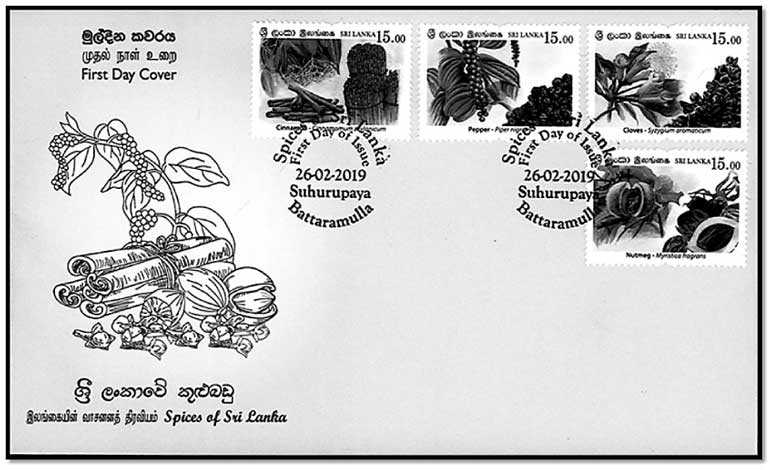Tuesday Mar 18, 2025
Tuesday Mar 18, 2025
Saturday, 21 September 2019 00:10 - - {{hitsCtrl.values.hits}}
Cinnamon, pepper, cloves and nutmeg in the spotlight

Cinnamon cultivation is also found along the coastal belt from Kalutara to Beliatta and from there to the interior up to Ratnapura. The Districts of Badulla, Hambantota, Colombo and Gampaha too are famous for cinnamon cultivation – Pic by Shehan Gunasekara
 Spices of Sri Lanka attracted foreign powers from early times. Merchants and travellers had carried reports to Europe of the wealth and fertility of the island and gradually European powers began to explore.
Spices of Sri Lanka attracted foreign powers from early times. Merchants and travellers had carried reports to Europe of the wealth and fertility of the island and gradually European powers began to explore.
Four types of spices with a demand in the world market – cinnamon, pepper, cloves and nutmeg – are featured in the Rs. 15 stamps.
Cinnamon
Even in very early times the country’s cinnamon was highly appreciated in Europe. The trade lay almost entirely in the hands of the Arabs, Persians and Chinese. They carried gems, cinnamon and elephants to African ports on the Red Sea and then overland to Europe.
Starting from the central hills cinnamon had spread to Kandy, Matale, Belihuloya, Haputale and certain parts of the Sinharaja forest.
Cinnamon cultivation is also found along the coastal belt from Kalutara to Beliatta and from there to the interior up to Ratnapura. The Districts of Badulla, Hambantota, Colombo and Gampaha too are famous for cinnamon cultivation.
Being a tropical plant, cinnamon is a crop that is cultivable under soil conditions which can withstand warm climatic conditions. Cinnamon is also cultivated in the silvery sandy or the white sandy soil, the loam soil and the gravelly laterite soil available in the intermediate and the wet zones of Sri Lanka and particularly in the Galle, Matara, Kalutara and Ratnapura Districts.
Pepper
Pepper, ‘Piper nigrum’ botanically, is the ‘King of Spices’ accounting for a higher quantity and a higher value in the international spice trade. Mostly used spice throughout the world, the annual demand for pepper is around 200,000 metric tonnes which amounts to around one-third of the volume of world spice trade.
Pepper is mainly grown in the districts of Matale, Kandy, Kegalle, Badulla, Ratnapura, Kurunegala and Nuwara Eliya. The estimated land area where pepper is around 30,000 hectares. Pepper can be grown either as a single crop or a mixed crop among tea and coconut cultivations. The cultivation can be done by the use of live or non-live supports. It is the mature small and dried pepper seed which is considered more important economically.
Since it is a wet tropical crop, it can be better cultivated in areas where the daily temperature changes are very minimal.
Pepper can be cultivated in areas up to about 1,000 metres above sea level with an annual rainfall of not less than 1750 mm. Pepper grows extremely well in the slightly acidic soil abundant in organic matter and about 60 cm deep with a good drainage of water.
Almost 90% of the total pepper imports is supplied by Indonesia, India, Vietnam, Malaysia and Brazil.
Cloves
Dried cloves have a demand in the world market. What is being sold are flowers which are fully grown yet not open in the inflorescences. The stems which bore the flowers and the leaves too have a commercial value.
Cloves grow in the Eugenia caryophyllata tree belonging to the family ‘Myrtaceae’ known in the botanical name Syzygium aromaticum.
The clove tree is of medium size with a symmetrical shape and a soft grey bark. At the beginning the tree consists of two or three branches from which more branches shoot upwards. When fully grown the trees generally reach a height of around 15-20 metres.
Flowers are borne in small terminal inflorescences numbering three to 10. A single inflorescence consists of three flowers. The calyx is made of a soft ovary at the top of which are four triangular sepals. Around the stamens of the bud there are four red petals.
Cloves grow very luxuriantly in wet tropical climatic areas and an annual rainfall of 1,750-2,500 mm is suitable for clove cultivation. It is necessary to have wet as well as dry spells of weather alternately for good flowering. Long spells of drought are not suitable.
Although clove is extensively cultivated in the mid-country, the low country wet zone too is suitable for clove cultivation.
The existence of an annual temperature of 15 to 30 degrees C is another reason for the success of clove cultivation.
Rich deep humous loam soil is extremely suitable for this crop and cloves are also grown in the laterite soil as well as the clay and sand mixed soil without obstacles for the spread of roots.
Clove plants are propagated through seeds and the seeds ripe in the tree should be collected and planted immediately. After obtaining seeds from the tree, since their viability is lost within 48 hours they should be planted immediately. Only seeds light green in colour are selected for planting since they are the healthy seeds.
The appropriate time for harvesting clove buds is the time when the colour of the petals turn yellowish pink from light green. The bunch of flowers is picked with stems. Flowers have to be plucked very carefully.
The buds should be separated from the stems and dried in the sun for four to five days until they become dark brown and hard. Once the stem of clove is properly dried it breaks when bent. When cloves are not properly dry they are soft and known as ‘cooker cloves’.
Out of clove buds which are of the correct age, 30% of dried cloves are available. Cloves which are very well dried (with 8%-10% moisture) can be stored in gunny bags up to two years.
In Ayurveda treatment, cloves are effective in tooth diseases, cures dyspepsia and controls gas and bile.

First Day Cover
Nutmeg (Sadikka)
The nutmeg – ‘Myristica Fragrans’ – plant was introduced to Sri Lanka around the 19th century. An evergreen plant which grows to a height of about 15-20 metres, its leaves are dark green in colour.
Nutmeg fruits are fleshy and hang down from the tree. There are grooves around the fruit and when ripe it turns yellow and splits from the top along the groove and opens showing the shiny seed which is covered over by a crimson network, the mace.
Nutmeg cultivation is spread in the wet zone districts including Matale, Kandy, Kegalle, Badulla and Nuwara Eliya. In village gardens both nutmeg and clove trees can be seen together.
Two products of spice can be obtained from the nutmeg tree. One is the kernel of the nutmeg seed and the other, the mace which is a slightly elastic network that covers the outer skin of the seed.
An evenly spread rainfall of 1,500-2,500 mm and an average annual temperature of around 20-30 degrees C is suitable for nutmeg cultivation. Covers are necessary during the first two to three years of nutmeg cultivation. Thereafter full sun light is suitable.
Ideal to grow nutmeg is the deep acidic clay soil and sandy soil with good drainage of water. Water-logged or marshy soil is not suitable.
Generally the nutmeg seed is used for propagation and only the dark brown seeds of fruits which split open should be selected for this purpose. Since the viability of the seed is lost after eight to 10 days, seeds should be planted as soon as possible.
Immediately after the fruits are split or when they are about to split, they are plucked by hand. Sometimes fruits are allowed to fall once the peel is split. The fruits are either separated into two by hand or are gathered in heaps to open on their own. The mace is separated from the place at which it is attached to the base of the seed with a small sharp knife.
The nutmeg fruit can also be soaked in water for four to 12 hours before the kernel is removed. Drying should be done until the kernel in the shell rattles.

Discover Kapruka, the leading online shopping platform in Sri Lanka, where you can conveniently send Gifts and Flowers to your loved ones for any event including Valentine ’s Day. Explore a wide range of popular Shopping Categories on Kapruka, including Toys, Groceries, Electronics, Birthday Cakes, Fruits, Chocolates, Flower Bouquets, Clothing, Watches, Lingerie, Gift Sets and Jewellery. Also if you’re interested in selling with Kapruka, Partner Central by Kapruka is the best solution to start with. Moreover, through Kapruka Global Shop, you can also enjoy the convenience of purchasing products from renowned platforms like Amazon and eBay and have them delivered to Sri Lanka.
Discover Kapruka, the leading online shopping platform in Sri Lanka, where you can conveniently send Gifts and Flowers to your loved ones for any event including Valentine ’s Day. Explore a wide range of popular Shopping Categories on Kapruka, including Toys, Groceries, Electronics, Birthday Cakes, Fruits, Chocolates, Flower Bouquets, Clothing, Watches, Lingerie, Gift Sets and Jewellery. Also if you’re interested in selling with Kapruka, Partner Central by Kapruka is the best solution to start with. Moreover, through Kapruka Global Shop, you can also enjoy the convenience of purchasing products from renowned platforms like Amazon and eBay and have them delivered to Sri Lanka.